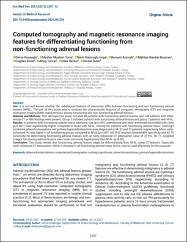Computed tomography and magnetic resonance imaging features for differentiating functioning from non-functioning adrenal lesions

View/
Access
info:eu-repo/semantics/openAccessAttribution-NonCommercial-NoDerivs 3.0 United Stateshttp://creativecommons.org/licenses/by-nc-nd/3.0/us/Date
2021Author
Köseoğlu, DeryaTuna, Mazhar Müslüm
Imga, Narin Nasiroglu
Ayçiçek, Bercem
Başaran, Mehtap Navdar
Şenel, Çağdaş
Tuncel, Altuğ
Berker, Dilek
Güler, Serdar
Metadata
Show full item recordAbstract
Aim: It is not well known whether the radiological features of adenomas differ between functioning and non-functioning adrenal
lesions (NFAL). The aim of this study was to evaluate the characteristic features of computed tomography (CT) and magnetic
resonance imaging (MRI) characteristics among functioning and non-functioning adrenal lesions.
Material and Methods: This retrospective study included 89 patients with functioning adrenal lesions and 148 patients with NFAL,
whose CT or MRI findings were present. Group 1 included patients with functioning adrenal lesions and group 2 patients with NFAL.
Results: In patients with functioning adrenal mass, adenoma size (p:0.001), unenhanced and early-enhanced Hounsfield units (HU)
(p<0.001) were significantly higher compared to those with NFAL. Among the patients with functioning adrenal mass; Cushing’s
syndrome, pheochromocytoma and primary hyperaldosteronism were diagnosed in 34, 32 and 23 patients, respectively. Mean earlyenhanced HU was higher in all functioning groups compared to NFAL (p<0.001, all). ROC analysis showed 80% specificity and 82.7%
sensitivity for determining functioning adrenal masses with an early-enhanced CT attenuation value of 27 HU. On T1-weighted
images functioning adrenal lesions were more commonly hypointense than NFAL (p=0.02).
Conclusion: This study reveals that functioning adrenal lesions might be differentiating from NFAL using CT features. Especially
early-enhanced CT attenuation, which is elevated in all functioning adrenal mass forms, may be used effectively for this purpose.
Source
Annals of Medical ResearchVolume
28Issue
12Collections
The following license files are associated with this item:


















